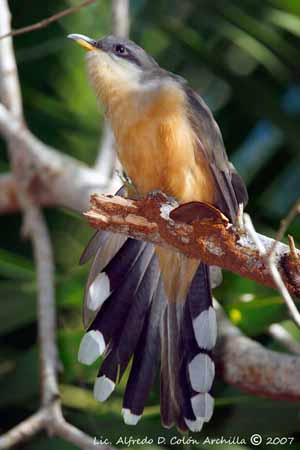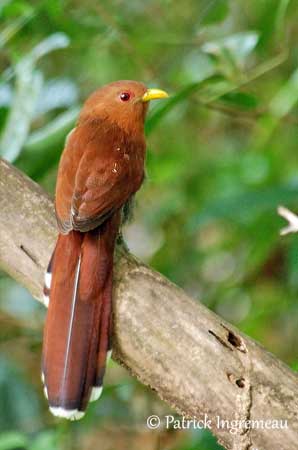
Photographers :
Alfredo Colón
Puerto Rico Wildlife
Marc Chrétien
MURINUS
Patrick Ingremeau
TAMANDUA
Bob Moul
Nature Photography
Philippe et Aline Wolfer
GALERIE
Text by Nicole Bouglouan
Sources :
HANDBOOK OF THE BIRDS OF THE WORLD vol 4 by Josep del Hoyo-Andrew Elliott-Jordi Sargatal - Lynx Edicions - ISBN: 8487334229
L’ENCYCLOPEDIE MONDIALE DES OISEAUX - Dr Christopher M. Perrins - BORDAS - ISBN: 2040185607
BirdLife International (BirdLife International)
CREAGUS@Monterey Bay (Don Roberson)
Wikipedia, the free encyclopaedia
CUCULIDAE FAMILY
Subfamily Coccyzinae
The subfamily Coccyzinae includes 18-20 species of American cuckoos gathered in four genera: Coccyzus, Saurothera, Hyetornis and Piaya. Both genera Saurothera and Hyetornis are now included into Coccyzus.
They are nest-building, non-parasitic cuckoos. They are mainly arboreal species, unlike the previous Centropodinae, but they also are insect-eaters.
These birds have almost similar long, graduated tail with black and white pattern.

Coccyzus minor
They frequent tropical lowland evergreen forest and tropical deciduous forest according to the species. They are usually found in wooded and forested areas such as gallery forest, secondary forest, open or scrubby woodland, shrubby pastures or with scattered trees.
They may be found in humid areas, mangroves, swamps, humid woodland edges, forest with seasonal flooding, low thickets and dense shrub near water.
These species can be found from sea-level to high elevation, up to 2600 metres in Colombia and sometimes more.

Coccyzus minor
The cuckoos formerly placed in genera Saurothera and Hyetornis are living in Caribbean islands and frequent forested areas too, but also coffee plantations, brush-covered limestone hills and semi-arid country with trees and shrubs.
They can be seen from lowlands up to 800/2000 metres of elevation.

Coccyzus vieillotti
The members of the genus Piaya are long-tailed cuckoos, showing the same black and white pattern and usually chestnut body colours.
The South American cuckoos frequent the same type of forested habitats at similar elevation. They also are insect-eaters.

Piaya cayana
The species of the subfamily Coccyzinae are insect-eaters, and also feed on caterpillars, but more rarely on frogs, fish and bird’s eggs. Fruit and berries are often consumed in summer and autumn. They also take spiders, snails and lizards.
They forage mainly in tree foliage, in canopy and subcanopy, but also in shrubs and on the ground.
The Yellow-billed Cuckoo (Coccyzus americanus) often perches motionless with cocked head, waiting for insects. When they move, it hops and grabs the prey.
The Mangrove Cuckoo (Coccyzus minor) perches in tree while scanning the vegetation. Then, it pursues the prey by hops and it also runs.

Coccyzus americanus
The lizard-cuckoos of the Caribbean Islands take small lizards, large insects and large spiders. They forage in middle storey and canopy, move through the branches, creep and crawl through the dense vegetation near the ground. They remain motionless for minutes.
The two former Hyetornis species from Jamaica and Dominican Republic often run along the branches and leap from tree to tree.

Coccyzus vieillotti
The cuckoos of genus Piaya forage in the same way, by hopping along limbs, and leap from branch to branch, run along the branches and glide across open areas with bursts of rapid wingbeats. They may perform short fluttering flights and are able to maintain sustained flight.

Piaya cayana
American cuckoos gives loud series of grating, guttural notes and calls.
The birds of genus Piaya give more rolling sounds and nasal chattering, dry rattles and scratchy descending notes.
SOME SOUNDS BY XENO-CANTO
Yellow-billed Cuckoo - Xeno-Canto

Piaya cayana

Coccyzus americanus
As other cuckoo species, the American cuckoos spread and raise the tail in courtship displays, in order to expose the bold white spots and the black and white pattern.
Courtship feeding is also observed during all stages of the nesting cycle.


Puerto Rican Lizard-cuckoo - Coccyzus vieillotti - DISPLAYING
Two species, the Black-billed Cuckoo and the Yellow-billed Cuckoo may occasionally lay in nests of other bird species. Both species breed in North America.
But usually, the Coccyzinae species build a flat platform of twigs and vines or leaves, or a shallow saucer of sticks and green leaves.

Black-billed Cuckoo
Coccyzus erythropthalmus
The Little Cuckoo (Piaya minuta) builds an open, deep cup with twigs.
Such nests are placed in thick vegetation or in trees or bushes at variable heights.

Little Cuckoo
Piaya minuta
The female lays 2-3/3-5 pale or white eggs. The incubation is often shared by both parents and lasts about 10-11 days in Coccyzus, and up to 18 days in Piaya. The young are fed by both adults and fledge between 12-14 and 18-20 days according to the species.

Ash-coloured Cuckoo
Coccyzus cinereus
Some American Cuckoos are migratory. The Black-billed Cuckoo and the Yellow-billed Cuckoo which breed in North America, migrate at night through Mexico and Central America, for wintering in South America.
The other Coccyzus are resident or seasonal austral migrants.

Ash-coloured Cuckoo
Coccyzus cinereus
The Caribbean species are resident in their range in Cuba, Puerto Rico, Hispaniola, Jamaica and Dominican Republic.
The Piaya species are resident.

Little Cuckoo
Piaya minuta
The American cuckoos are not globally threatened, but they are usually rare or uncommon. Some of them can be fairly common or locally common according to the range and the type of habitat.
The Caribbean species are relatively common in their restricted range.
The Rufous-breasted Cuckoo (Coccyzus rufigularis) is Vulnerable and occurs mainly in protected areas.
In the Piaya species, the Squirrel Cuckoo is generally common in most part of the range in South and Central America.
The Black-bellied Cuckoo (Piaya melanogaster) is uncommon and sensitive to habitat disturbance.
The Little Cuckoo is uncommon to fairly common throughout most of its range.

Black-bellied Cuckoo
Piaya melanogaster

Coccyzus melacoryphus
These species are vulnerable to disturbances and degradation of the habitat. Some of them are living in restricted range, and are trapped and killed for use in traditional medicine.

Coccyzus minor